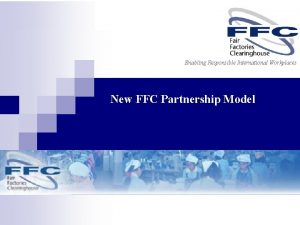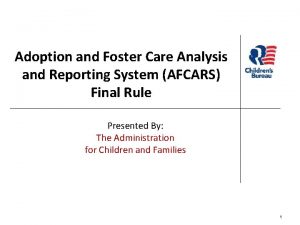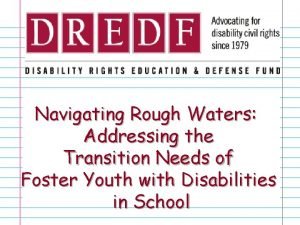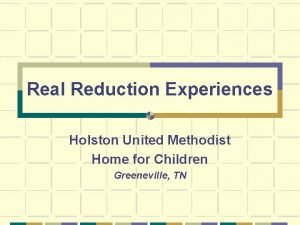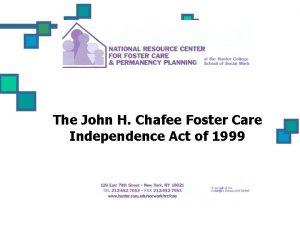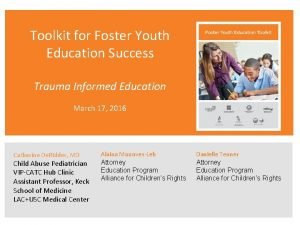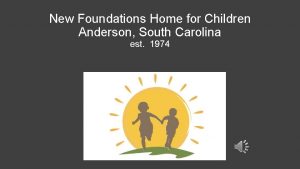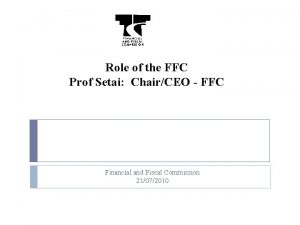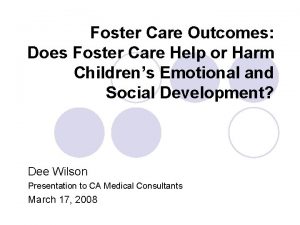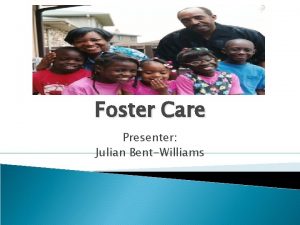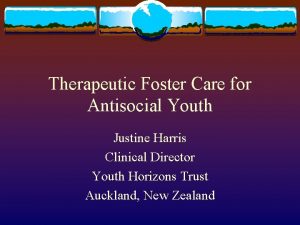Family Foster Care FFC and Therapeutic Foster Care







- Slides: 7

Family Foster Care (FFC) and Therapeutic Foster Care (TFC) Parents' Motivation, Stress and Satisfaction with Fostering: Part 3 Michael Brand, Ph. D. David Bard, Ph. D. Keri Pierce, MSW. , MPH. The University of Oklahoma Health Sciences Center

Method • Item Factor Analysis of 24 Motivation Items – Exploratory Factor Analysis • Weighted least squares estimation for categorical indicators with missing data (uses Probit link function) • Scree plot informed solution • Promax transformed loading matrix – Confirmatory Factor Analysis • Weighted least squares estimation for categorical indicators with missing data (uses Probit link function) • Correlated factor solution freeing EFA loadings >. 3 • Control for mean differences due to parent (mom/dad), certification (Traditional/TFC), family income, & # of bio children in the home • Mediation Models – Explore indirect influence of Motivation on overall Satisfaction through parental strain, resources, and alliance • Delta method standard errors and t-tests performed • All models run in Mplus 4. 1 for Windows

Item Factor Analysis of Foster Parent Motivation Items • Exploratory Analysis of 24 Motivation Items – 2 items excluded based on bad performance (loaded weakly or exclusively on factors) • My parents were foster parents • Want to foster particular child – Scree plot of Eigenvalues from remaining 22 items suggested 4 factors • • • Concern for Children Foster Reciprocity (Once was a foster child, want to give back) Adoptability (One step closer to adoption qualification) Financial Benefit Confirmatory Model – Fit of 4 factor Confirmatory unsatisfactory – 4 more items excluded based on CFA performance (low R 2 values) • • My spouse wanted me to Want to continue parenting Religious belief- helping others Knew other foster parents – Final model fit acceptable • All t-values for factor loadings significant (p <. 05) • RMSEA = 0. 05 • CFI =. 95

Mean Differences in Confirmatory 4 Factor Model * Denotes an associated t-value with p <. 05 • Estimates represent the mean difference in the standardized latent factor per unit increase in the predictor. • Significant effects after controlling for other 3 predictors • Fathers showed less concern for children and less foster care reciprocity. • Therapeutic foster parents showed more concern for children, less motivation for adoption, and more financial motivation. • Those with higher # of biological children in the home showed less concern with children and more desire for financial benefit. • Those of higher income showed less concern for children and less desire for improving adoptability.

Mediation Model Motivation Concern Personal Mediating Factors -0. 38* 0. 36* Strain -0. 29* Foster. Care Satisfaction 0. 36* -0. 30* -0. 15* -0. 22* 0. 38* Resources 0. 07 Satisfaction 0. 09 -0. 25* Adopt 0. 17* 0. 24* Finance -0. 39* 0. 40* Alliance Effects represent SD change in outcome for SD change in predictor, after controlling for influences from parent, certification, income, and #bio kids. The nonsignificant direct effects from latent motivation variables to Satisfication not depicted.

Indirect Effects of Motivation on Satisfaction • Only Personal Strain significantly mediated Motivation effects on Satisfaction. As expected, more Strain led to less Satisfaction. – Less Concern for Children led to more personal strain. A SD increase in latent Concern led to a. 09 SD increase in observed Satisfaction. – The more one’s own foster child experience motivated foster parenting, the more strain the individual reported. A SD increase in Foster Reciprocity led to a. 08 decrease in Satisfaction. – One’s desire to adopt led to less personal strain. A SD increase in Adoptability led to a. 03 increase in Satisfaction. – As financial motivation increased, so too did personal strain. A SD increase in Financial Benefit resulted in a. 08 decline in Satisfaction.

Implications • Mean Differences in Motivation – Foster fathers may be less involved in foster care decisions and parenting as noted by their ↓ concern for the children. – TFC parents, while reporting ↑ concern for children, may be just as impacted by the increased financial incentives for parenting difficult children. Likewise, those with biological children already in the home, may be enticed by the increase in wages for taking on another child. – Foster parents of ↑ income did report ↓ Concern for children, which may reflect a relative difference compared to foster parents of more meager means who make the same sacrifice. • Mediated Effects of Motivation on Satisfaction – While all four motivation factors significantly predicted personal strain, coping resources, and parental alliance, only personal stain seemed to mediate effects on satisfaction. As expected, higher strain led to lower satisfaction. – Greater Concern for Children and Desire for later Adoption indirectly predicted higher levels of satisfaction. Conversely, higher foster-care reciprocity and financial incentives predicted lower levels of satisfaction.
